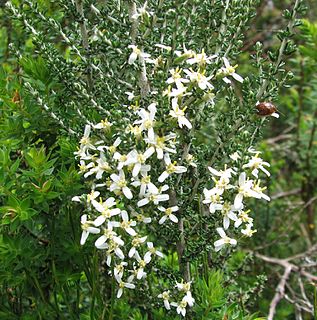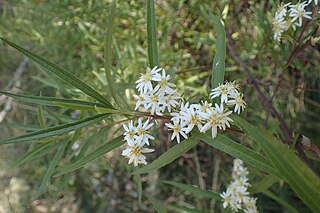
Olearia argophylla, commonly known as musk daisy-bush, native musk or silver shrub, is a species of flowering plant in the family Asteraceae and is endemic to south-eastern Australia. It is a shrub or tree with silvery branchlets, egg-shaped to elliptic leaves, and white and yellow, daisy-like inflorescences.

Olearia axillaris, commonly known as coastal daisy-bush, coast daisy-bush or coastal daisybush is a species of flowering plant in the family Asteraceae and is endemic to coastal areas of Australia. It is an erect, bushy shrub with densely cottony-hairy branchlets, aromatic, linear to narrowly elliptic or narrowly lance-shaped to egg-shaped leaves with the narrower end towards the base and small white and yellow, daisy-like inflorescences.

Olearia phlogopappa commonly known as the dusty daisy-bush or alpine daisy-bush is a species of flowering plant in the family Asteraceae that is commonly found in eastern New South Wales, Victoria and Tasmania. It is a small shrub with greyish-green foliage, daisy-like flowers in white, pink or mauve that can be seen from spring to late summer.

Olearia algida, the alpine daisy-bush is a species of flowering plant in the family Asteraceae and is endemic to south-eastern Australia. It is a shrub with small, crowded, elliptic to narrow egg-shaped leaves with the narrower end towards the base and heads of white and cream-coloured, daisy-like flowers.

Olearia viscidula, commonly known as the viscid daisy bush or wallaby weed, is a species of flowering plant in the family Asteraceae and is endemic to eastern New South Wales. It is a shrub with scattered narrow elliptic or egg-shaped leaves that are paler on the lower surface, and panicles of white flowers arranged in leaf axils.

Olearia floribunda, commonly known as heath daisy-bush, is a species of flowering plant in the family Asteraceae.

Olearia astroloba, commonly known as marble daisy-bush, is a species of flowering plant in the family Asteraceae and is endemic to a restricted area of Victoria in Australia. It is a greyish shrub with sessile, spatula-shaped leaves and mauve or violet and purple, daisy-like inflorescences.

Olearia elliptica, commonly known as the sticky daisy bush, is a shrub in the daisy family, Asteraceae and is native to New South Wales and Queensland in eastern Australia. It has scattered, sticky leaves and white flowers in summer and autumn.

Olearia asterotricha, commonly known as rough daisy-bush, is a species of flowering plant in the family Asteraceae. A tall shrub with white, mauve or blue daisy like flowers growing from the Blue Mountains in New South Wales to western Victoria, Australia.
Olearia adenolasia, commonly known as woolly-glandular daisy-bush, is a species of flowering plant in the family Asteraceae. It is a small upright shrub with sticky leaves and blue-purple or white daisy flowers.
Olearia aglossa, is a shrub in the family Asteraceae and is found in mountainous terrain in New South Wales and Victoria in Australia. It is a small shrub with spreading upright branches and white daisy-like flowers.

Olearia magniflora, commonly known as the splendid daisy-bush, is a small shrub with clusters of deep mauve to purple flowers.

Olearia ciliata, commonly known as the fringed daisy bush, is a small shrub with large clusters of bright purple-blue flowers on a single stem.

Olearia oppositifolia is a species of flowering plant in the family Asteraceae and is endemic to eastern Australia. It is a shrub with egg-shaped to elliptic leaves arranged in opposite pairs, and white and yellow daisy flowers.

Olearia paucidentata is a plant in the Asteraceae family. It was first described as Eurybia paucidentata in 1845 by Joachim Steetz. In 1867, George Bentham assigned it to the genus Olearia in his Flora Australiensis.

Olearia archeri is a species of flowering plant in the family Asteraceae and is endemic to Tasmania. It is a shrub with small, crowded, narrowly elliptic leaves and white and yellow, daisy-like inflorescences.
Olearia arckaringensis, commonly known as Arckaringensis daisy, is a species of flowering plant in the family Asteraceae and is endemic to a restricted area of northern South Australia. It is a small, compact, rounded shrub with woolly-hairy foliage, coarsely-toothed, elliptic leaves and lavender or white and yellow, daisy-like inflorescences.

Olearia brachyphylla is a species of flowering plant in the family Asteraceae and is endemic to southern continental Australia. It is a densely-branched, aromatic shrub with woolly-hairy stems, oblong to egg-shaped leaves with the narrower end towards the base and small white and pale yellow, daisy-like inflorescences.
Olearia burgessii is a species of flowering plant in the family Asteraceae and is endemic to south-eastern New South Wales. It is a shrub with scattered elliptic to egg-shaped leaves with the narrower end towards the base, and white and yellow, daisy-like inflorescences.

Olearia calcarea, commonly known as limestone daisy bush, is a species of flowering plant in the family Asteraceae and is endemic to southen continental Australia. It is a shrub with egg-shaped or broadly spoon-shaped leaves with toothed edges, and white and yellow, daisy-like inflorescences.

















